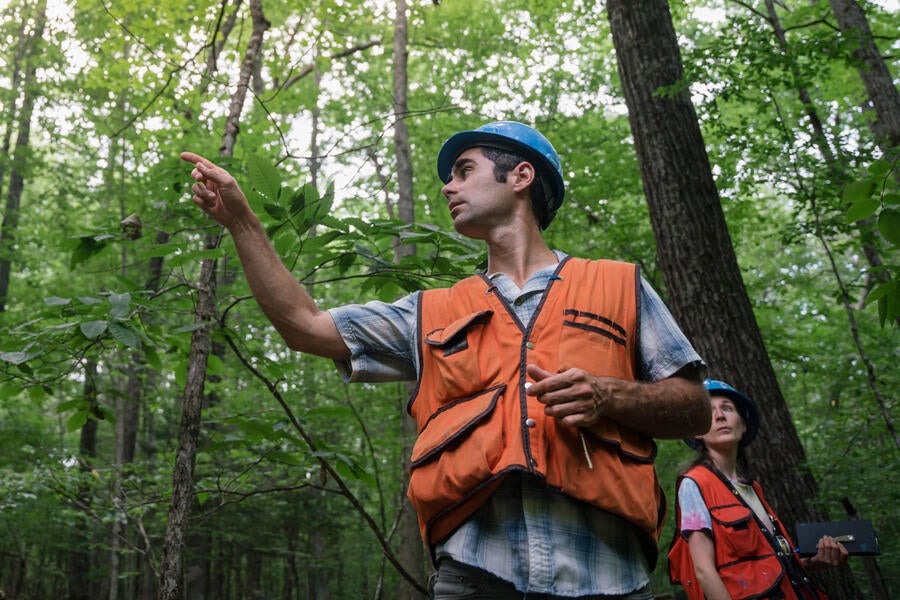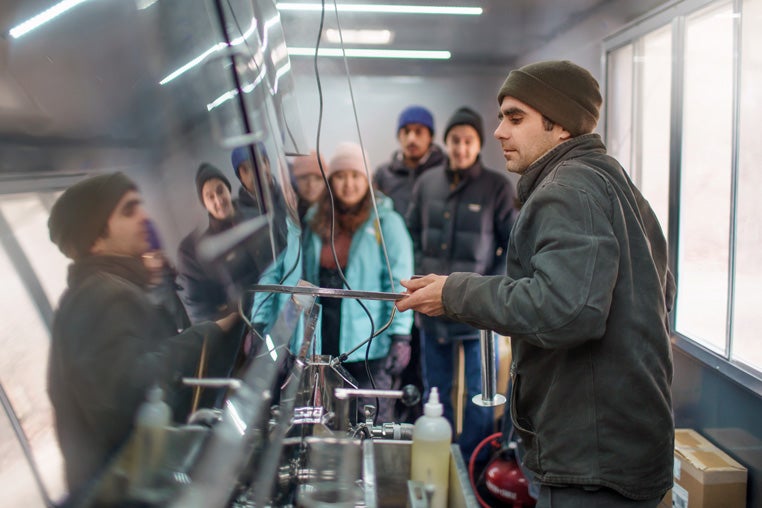
Yale University has many holdings, including buildings, artwork, two power plants, and 10,592 acres of forests located in Connecticut, Vermont, and New Hampshire. The largest tract, the Yale-Myers Forest, encompasses 7,840 acres in northeastern Connecticut, an area of the state known as “the quiet corner.”
Managing the Yale Forests is a hands-on component of forestry education at the Yale School of the Environment (YSE). As director of forest and agricultural operations, Joe Orefice shares oversight of Yale’s five forest properties, co-manages the apprentice forester program, and is a lecturer at YSE. During the academic year, he teaches several courses on forest management, agroforestry, and the popular “Maple: from Tree to Table.”
There are genuinely thoughtful and caring students, staff, and faculty working and studying here from all over the world.
During the summer season, Orefice is based at the Yale-Myers Forest. He is responsible for maintaining any buildings or structures on the forest properties and works with Yale Facilities on project planning for repairs or renovations. Throughout the summer, researchers from Yale and other universities often study soil carbon, pollinators, or the predator/prey relationship in these forests.
Orefice lives on his 134-acre Hidden Blossoms Farm in Union, CT, where he raises grass-fed beef and grows tomatoes and figs. He spoke to YourYale about introducing maple syrup production at the Yale-Myers Forest, the destructive emerald ash borer beetle, and the price of timber. This interview has been lightly edited and condensed.
What made you decide to become a forest manager and study forestry management?
What excites me about forestry is the intersection of science and practice, making it mentally engaging. I liked being outdoors, and I knew I didn’t want an office job, so forestry sounded appealing. We had a forester on my family’s farm who encouraged me to look at the University of Maine’s forestry program. I did and found it was a good way to be able to interact with nature and to think about how ecosystems work.
Describe a day in your life.
During the academic year, I teach on campus twice a week, and I run two field trips with YSE students. We visit the pine belt in southeastern Georgia and other forested areas of Florida, Alabama, and the Carolinas during spring break. YSE students have been attending these field trips to learn about forest production and other cultural dynamics since 1907. We also hold a joint field trip, started in the 1980s, with the Technical University of Munich in Germany.
When summer arrives, you can find me at any of the forests, but primarily at Yale-Myers, working with logging contractors, planning or implementing facilities work, and interacting with the student apprentices or visitors conducting research. Yale Forests are maintained as working forests, which include harvesting and selling timber, firewood, and non-timber forest products such as maple syrup produced from the land. Revenue from these products directly supports the educational opportunities the forests provide. Unfortunately, timber prices have decreased in recent years and have been less profitable for us. But I hope to start selling the maple syrup through Yale Hospitality’s retail locations. It is really delicious!
 Orefice demonstrates how to operate a modern wood-fired maple syrup evaporator. It cuts down on fuel use and aids in sustainable maple syrup production.
Orefice demonstrates how to operate a modern wood-fired maple syrup evaporator. It cuts down on fuel use and aids in sustainable maple syrup production.
How is your work affected seasonally?
In the spring, we produce maple syrup. I introduced this initiative in 2022 as an example of agroforestry — a farming system that integrates trees. It’s part of the Maple Education and Extension Program at YSE. Students and faculty built the sugarhouse and installed the sap collection infrastructure at the Forest. This past year we bottled 115 gallons of maple syrup.
The summer is active with the apprentice forester program. This forest crew is led by two faculty members, me included, and a recent graduate who is appointed for a one-year term. These students enable us to maintain the forests, and they get hands-on experience inventorying and analyzing forest stands while controlling the establishment, growth, composition, health, and quality of the woodlands. They also check property boundaries, maintain forest roads, and develop and monitor timber sales.
In the fall and wintertime, I keep busy with academics, teaching, and year-round forest management.
How has climate change affected the forests or your day-to-day work?
As part of our ongoing research, climate change is always included in the conversation. Its effect on the forests is gradual right now. In the short term, our forests are being affected by invasive species — a problem that exists regardless of climate change and can be worsened by it. Currently, we are losing many white, black, and green ash trees because of the emerald ash borer, a non-native insect. Sadly, there is not much to do to save these trees. It’s a big loss, and we hope the species rebound, but it will take a century or more for that to happen, if at all.
Where do you find inspiration?
One of the reasons I came back to Yale is the people in addition to the work and research being done here. There are genuinely thoughtful and caring students, staff, and faculty working and studying here from all over the world. I draw all kinds of inspiration from the forests and the people I get to teach and interact with.
What changes have you seen throughout your career?
I’ve been teaching for 15 years. In the forest, I’ve seen different diseases and invasive species, which is interesting and sad at the same time. There have been changes in what professional foresters care about, including thinking about climate change. Also, a generational shift is happening, with many foresters now entering the profession in a world of ecological and climate forestry. Thirty years ago, the focus was often on production forestry. Now we talk about the multi-use aspects and climate change in the role of forests as if they have always been the priority.
What advice would you give someone who wants to get into forestry or forestry management?
Anyone interested is welcome to come talk to us at YSE! We are happy to give guidance on academics or career options. We can also connect you with a forester who works at the state or local level so you could learn how they got into the profession and what they do. Foresters are very accessible people, and most would be happy to talk about their work.
Tell us a few fun facts about the Yale-Myers Forest:
- Yale-Myers Forest has more tree species than Yellowstone National Park.
- It is Yale’s largest academic landholding encompassing 7,840 acres in the towns of Ashford, Eastford, Union, and Woodstock, Connecticut.
- The Nipmuck Trail runs through it.
- In 2023, 115 gallons of maple syrup was produced from 210 trees.






